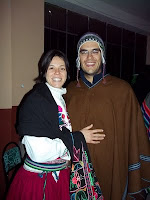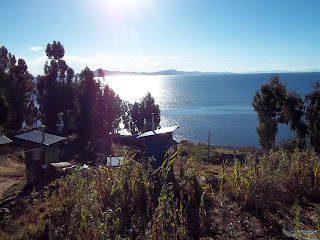The excursion boat of about 25 of us went first to the Floating Islands of Uros. It is hard to describe them, so I will quote my Lonely Planet guidebook. "These islands are built using many layers of the buoyant totora reeds that grow abundantly in the shallows of the lake, and are constantly replenished from the top as they rot from the bottom, so the ground is always soft and springy." On top of this they build reed huts, which they live in, and build reed boats and make handcrafts. Our guide on the excursion boat said that each of the 47 to 50 floating islands can be 400 to 550 square feet, and they can be roped to each other. An individual island can exist for up to 50 years, at which time the whole mass of sodden reeds become too heavy and eventually sinks under its own weight.
The local people have a rich heritage and greet tourists in bright-colored costumes. The islands were like nothing I had ever seen or experienced.
All of the islands we visited in the two days have become very commercialized, unfortunately, and the local villagers' simple way of life has become intertwined with the tourism industry. The ever-present handcrafts for sale, seen everywhere I visited in Peru, are the way many people make a living. As a tourist I love seeing their colorful and interesting way of life, which is very different than mine. On the other hand, I hate to see their uniqueness fall under the spell of commercialism. Either way, capitalism is alive and well in Peru.
The second island we visited was Amantani, where we were matched up with a local family for the night. Three of us from the boat followed Nicolas, the family patriarch, for about 15 minutes around the island and up a slope, past his terraced fields of quinioa, corn, wheat, potatoes, etc. to his home.
In my case, I had a room to myself, and a young couple from Brazil, Bruna and Andre, had another room. The family members slept elsewhere in the adobe brick family compound that included the parents, two daughters, and their children. The daughters' husbands were off working in Lima, where presumably they could make more money.

The island of Amantani has 4,000 residents in 10 different communities, and are as self-sufficient as modern living allows. They have some sources of power (generator, solar power) which they use sparingly. The adobe kitchen and eating room had a dirt floor and was a bit smokey from the wood stove and little ventilation.
We ate three meals that the family provided --- all locally grown or produced. Examples: quinioa soup, several types of potatoes, beans, cheese, homemade bread, eggs, tomatoes, and various teas, including the ever-present coca tea to stave off the effects of high altitude, allegedly.
 The evening entertainment was to dress us gringos in native garb and send us off to a fiesta, complete with a local band. In the photo are Bruna and Andre all dressed up for the fiesta. We had the opportunity to purchase cerveza (beer), but I declined since we had climbed some hills on rocky paths to get there, and I didn't want to break my neck getting back in the dark. Everyone from the boat was dressed in the same colorful costumes, and we made up our own versions of Peruvian circle dances.
The evening entertainment was to dress us gringos in native garb and send us off to a fiesta, complete with a local band. In the photo are Bruna and Andre all dressed up for the fiesta. We had the opportunity to purchase cerveza (beer), but I declined since we had climbed some hills on rocky paths to get there, and I didn't want to break my neck getting back in the dark. Everyone from the boat was dressed in the same colorful costumes, and we made up our own versions of Peruvian circle dances.  Back at the hacienda afterwards, I slept remarkably well and awoke to a spectacular view of Lake Titicaca from my bedroom window. After an excellent breakfast of eggs with homemade bread, we boarded the boat for the next island.
Back at the hacienda afterwards, I slept remarkably well and awoke to a spectacular view of Lake Titicaca from my bedroom window. After an excellent breakfast of eggs with homemade bread, we boarded the boat for the next island.Our next stop was the island of Taquile (not to be confused with the drink tequilla). Taquile is much smaller than Amantani with a population of 2,000. We walked up an inclined stone ramp that took a third of the island to get to the top, or so it seemed. At the end of our 3-hour visit, we walked down 500 steps to get to the dock, where our boat had moved to pick us up.
Our stay here included lunch, though many of us were still full from breakfast. Our guide provided a description of the traditional attire of this island: Men do the knitting here, and the color of their knit hats indicates marital status. A man with a red hat is married. A man with a white and red hat is single. Both men and women wear colorful costumes, presumably every day and not just when the tourists show up.









No comments:
Post a Comment